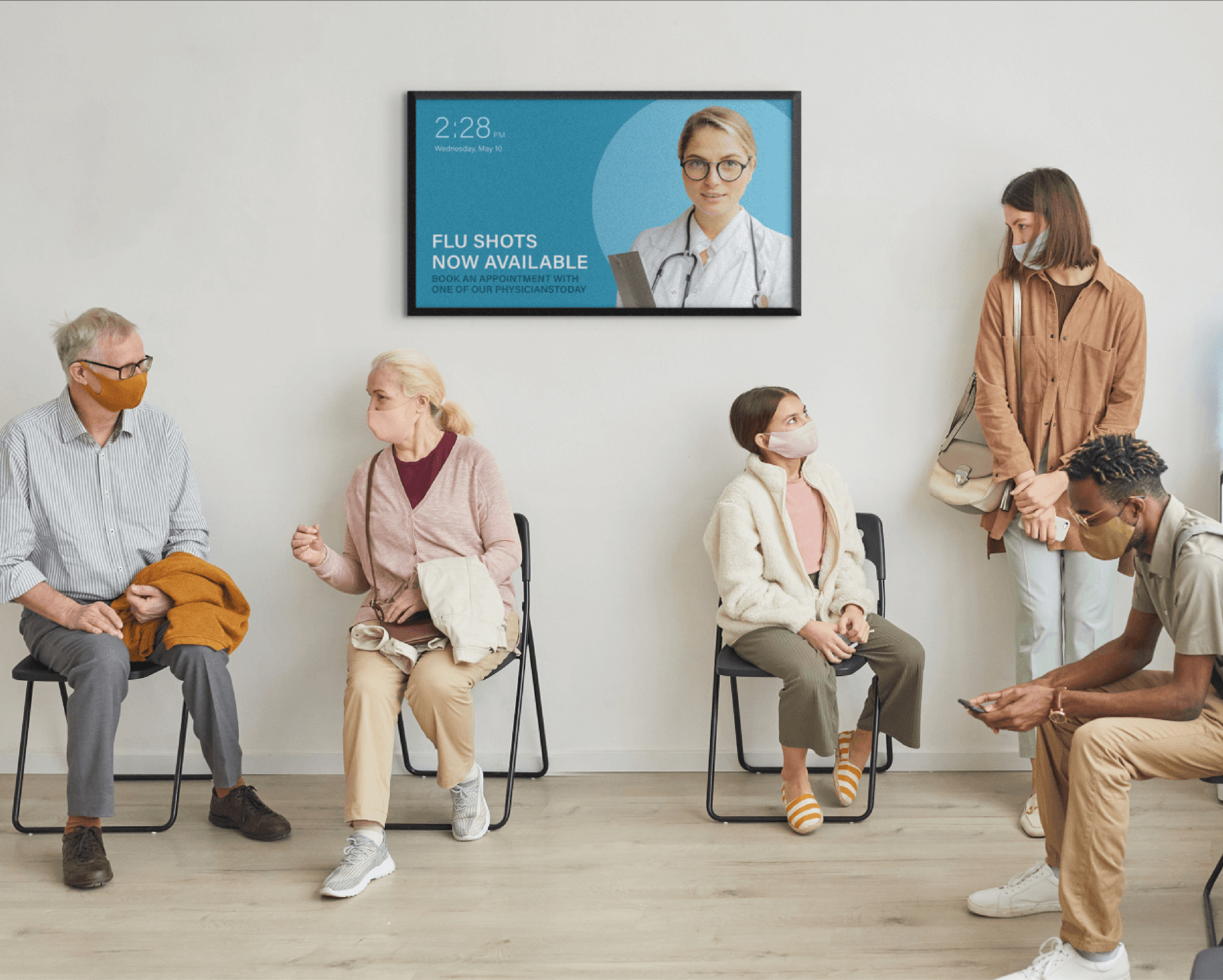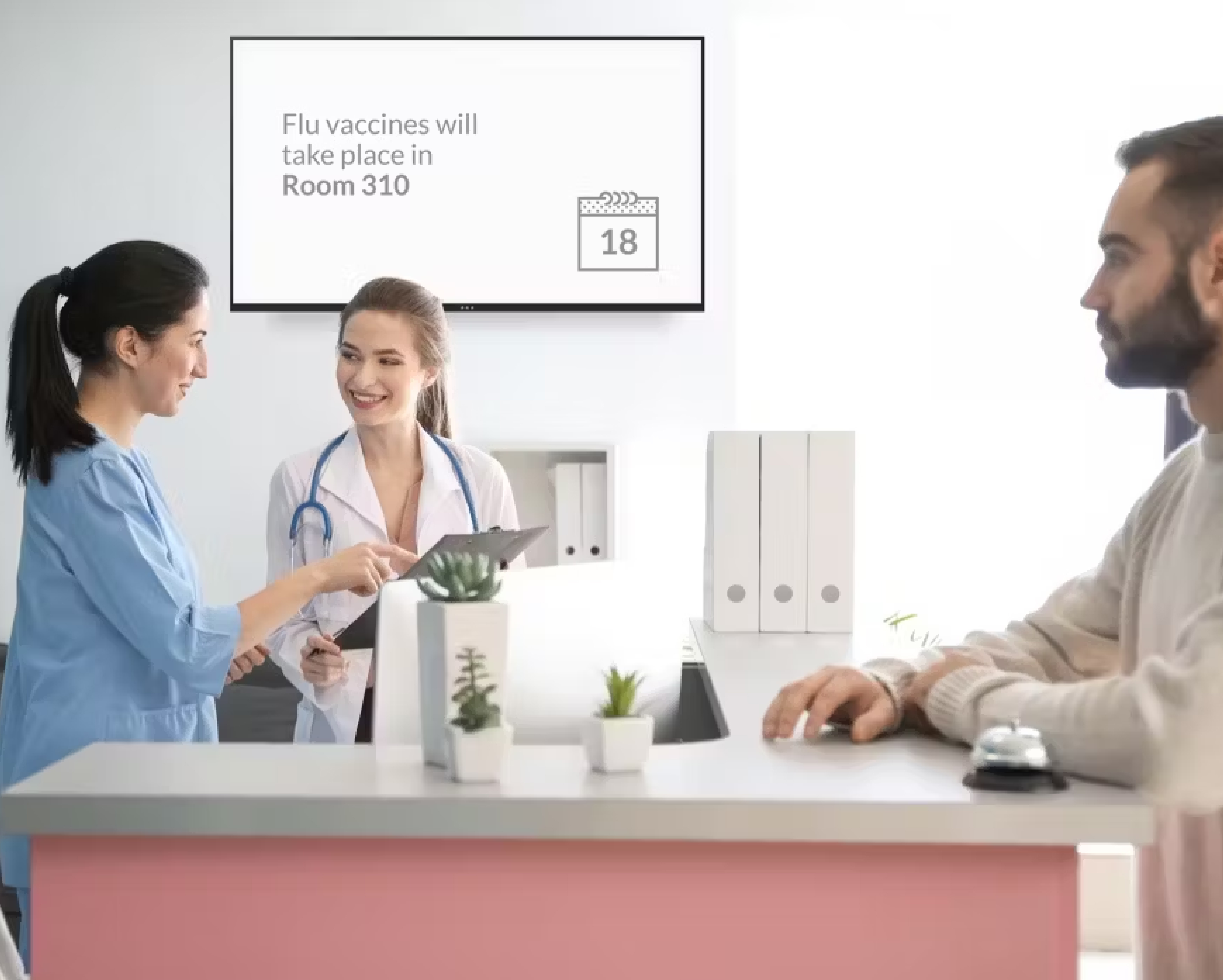Digital signage is a powerful solution for improving patient experience. You can streamline communication, engage patients, and even enhance the ambiance of your healthcare facility.
However, the true effectiveness of digital signage hinges on one critical element — and that is content.
The truth is, no matter how robust or versatile your solution is, the content you share plays a pivotal role in its success.
What type of content will your patients find useful? Are you sharing enough to engage patients without overwhelming them? What kind of content does your hospital staff need? These are crucial questions to answer to get your content strategy right.Let’s explore the key ways to craft impactful digital signage content for your healthcare ecosystem.
Educational Videos
You can simplify healthcare concepts with engaging, high-resolution videos. Explain health conditions, demonstrate preventive measures, and guide patients through common medical procedures with crisp and clear videos.
Why these work:
According to Forbes, viewers retain 95% of information when they watch it on video, versus 10% via reading text. This is because the brain transmits visual information faster than text, making it easier to understand complex concepts through video.
By using visual aids and storytelling techniques, you can make your digital signage healthcare content more accessible to diverse audiences — enhancing comprehension and retention overall.
Steps for implementation:
- Decide content topics: Make a list of the topics and subtopics you want to cover so you can outline an execution plan accordingly.
- Start content creation: Collaborate with healthcare professionals, creative strategists, and video editors to develop easy-to-understand scripts. You can incorporate diagrams, motion graphics, and charts to enrich the content.
- Share content strategically: Strategic content-sharing is critical to its success. You want to share this type of content in high-traffic areas like waiting rooms and cafeterias for patients to see and learn from.

Wellness Tips and Infographics
Infographics are great for sharing crisp information in a visually appealing, easy-to-consume way. You can use bullet-point lists and flowcharts to offer quick wellness tips, best practices, and preventive healthcare advice that’s easy to comprehend. That’s why they’re a popular choice for digital signage content in healthcare settings.
Why they work:
Infographics are visually attractive, with fun colors, bite-sized information, and relevant graphics. They easily capture the attention of your patients and employees without overwhelming them with truckloads of information. These snippets of knowledge can promote healthy habits and raise awareness among both your patients and employees about various healthcare topics.
Steps for implementation:
- Ensure content variety: Share infographics on various health themes, like mental health, exercise, and nutrition to keep your content fresh.
- Embed interactive elements: For instance, you can use QR codes to redirect your patients to your desired landing page. If your infographic talks about mental health, you can redirect your patients to a blog on mental health best practices to prompt them to read more about it.
- Make design consistent: One big reason why infographics work well is because they are aesthetically pleasing. Using consistent fonts, brand colors, and appropriate sizes makes your graphics appealing and easy to read.
Bonus: They also add to your unique brand identity and help with brand recall.
Real-time Updates and News
Sharing important updates with your staff in real-time is critical for quality patient care. These include patient information, staffing schedules, healthcare best practices, and emergency messages in case of natural calamities or security threats.
Health news, medical breakthroughs, and public health advisories are also useful healthcare digital signage content to keep your staff informed and aware.
Why these work:
They’re quick and actionable, enabling real-time communication for streamlined workflows. Unlike static posters and bulletin boards, digital signage makes content editing and updating easy with a few easy clicks. This way, your staff does not have to go through the hassle of replacing posters manually or searching through emails to find the information they need.
Steps for implementation:
- Share targeted messages: Digital signage solutions like L Squared support advanced device segmentation so you can share targeted messages to specific displays on your network.
For example, you can share registration information and best practices on screens near your registration counters while displaying shift schedules and patient room numbers on screens near nursing stations.
- Built an emergency notification system: Sharing messages on the spot is critical in sensitive situations like security threats or natural calamities. L Squared’s built-in emergency communication system overrides your current signage with emergency messages on targeted screens.
This way, the emergency notifications are disseminated instantly to targeted screens only — without causing any false alarms or panic in other areas.

Livestream hospital events
Picture this: Your holiday fundraiser is around the corner, and your event list is set. You have a few exciting things lined up — including donation drives, seminars, and even a treasure hunt for the kids!
However, some of your staff are working on the clock and patients are waiting anxiously for their appointments. What better way to make them feel included than to bring this experience to where they are?
That’s where your digital signage comes in. You can live stream all these events on your display screens and create a real-life experience for viewers in different parts of your facility.
Why these work:
Livestreams work because they break down physical barriers, allowing everyone to partake in these events, albeit virtually. This digital signage healthcare content also transforms passive waiting times into moments of engagement and connection, making patients and staff feel part of the events.
Steps for implementation:
- Plan ahead: Ensure your signage system is up and running for smooth operations. Map out which screens will stream the event so you can segment them beforehand.
- Include interactive elements: Interactive elements like quizzes and polls boost engagement to the next level! You can use QR codes for trivia, polls, and more to encourage active participation.
Patient stories and testimonials
Patient stories bring a personal touch to your digital screens. These can be video interviews or written reviews from patients who want to share their healthcare journeys. This type of digital signage healthcare content focuses on their experiences, recoveries, and the care they received.
Why these work:
Patient stories deeply resonate with viewers, adding a layer of hope and inspiration. They humanize the entire healthcare experience and help patients build trust and hope in their healthcare providers.
Steps for implementation:
- Get patient consent: First things first, getting your patient’s consent is crucial for this type of content. If some patients decline, don’t push them to agree — Move on to the next one for permission.
- Produce video content: Schedule a date to shoot this content if you’re opting for a video interview. You can do it yourself or invest in professional videographers to get high-quality video production.
- Include diverse perspectives and cases: Feature a range of patient stories to highlight the diversity of your patient community and the extent of services availed.

Experimenting with frame layouts
We’ve discussed some of the healthcare content formats you can play around with. Now, let’s discuss their presentation.
Most digital signage solutions allow you to share content in frame layouts. Think of it as having mini windows within one main frame. However, some solutions are more flexible than others when it comes to customizing the frames.
With L Squared, you can opt for built-in templates or build custom designs. This allows you to create a unique visual experience by mixing different content types within multiple frames.
For example, you can select a template that divides the screen into three sections. You can add an infographic in the first frame, the weather app in the second, and the time widget in the third. You can customize the size of each frame and play around with content placement.
Takeaway
The bottom line is that your healthcare digital signage content is crucial to the success of its implementation. These five ways are just a few examples to get you started. Remember, if you can dream it, you can display it!
Don’t be afraid to experiment with content formats, layouts, and wireframes. Test out different layouts for a specific time frame and then change it up. See how your audience reacts to it – Do they notice the difference? Is there a certain format that’s a crowd favorite? Do they find your content useful?
You can also send out surveys to get more direct and actionable feedback. Add a mixture of Yes/No questions and slightly more descriptive ones. Ask your viewers if they enjoyed the content or learned anything from you, or even if they ignored it completely!
This way, you can get a fuller view of how well your signage content is received, so you can double down on what’s working and let go (or improve) on the rest.



